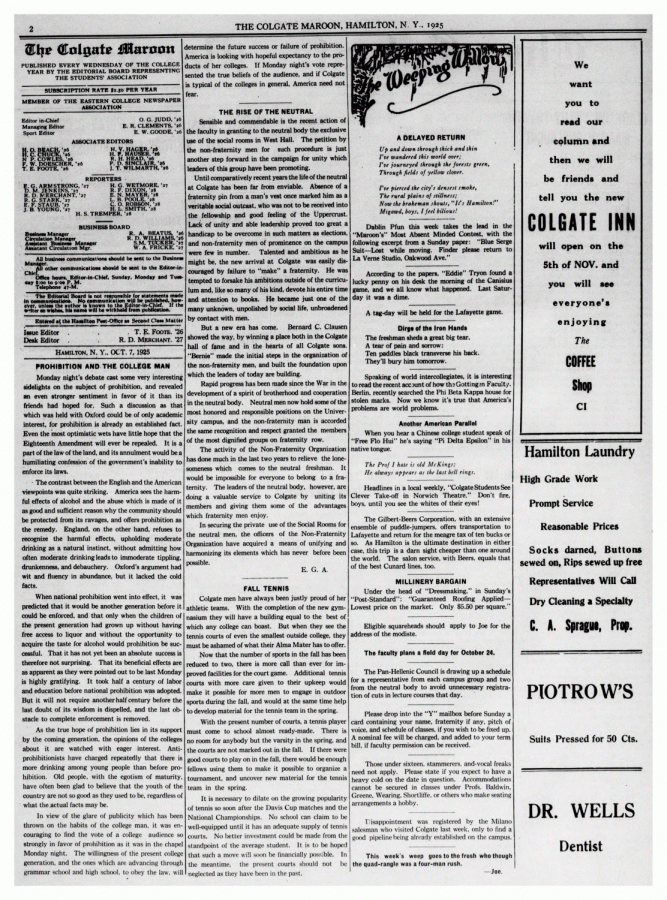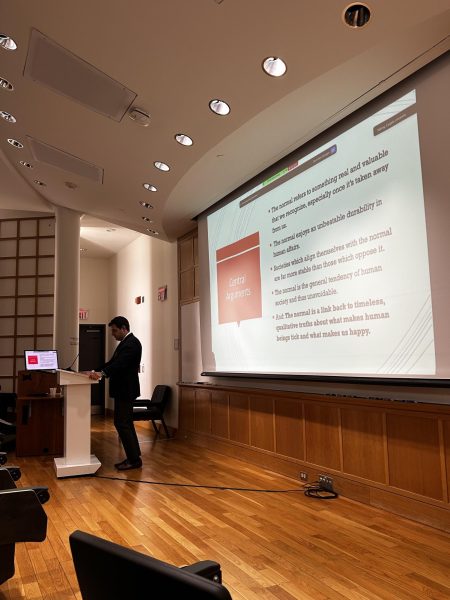How The Colgate Maroon-News Reported on Alcohol During Prohibition
If one were to open up any modern issue of The Colgate Maroon-News, they would quickly find one of the most popular sections, The Blotter, which records student infractions of university policy as noted by Colgate’s Campus Safety and, at times, the Hamilton Police Department. In The Colgate Maroon-News’ annual tally of infractions over the past decade, one of the most dominant is that of alcohol, whether underage students are found in possession of alcohol, or students are transported to the hospital for alcohol poisoning.
In perusing the vast records of the newspaper to examine the ways in which student consumption of alcohol has been discussed over the 150 years of Maroon-News coverage, a closer look was given to the Prohibition era, both in the early days of implementation and in its final days as the country anticipated the repeal of the Eighteenth Amendment.
On April 6, 1922, Professor of Chemistry R.B. Smith submitted an article to The Colgate Maroon warning students “to beware of illicit beverages.” Apparently, bootleg liquor had been brought into Hamilton. Writing from a scientific point of view, Smith warned students not to consume bootleg alcohol because the chemical makeup of alcohol during Prohibition increased dramatically in toxicity, as it was no longer regulated by the Food and Drug Administration. Rather than try one’s luck with bootleg liquor, Smith suggests that “if you need excitement, experiment with nitroglycerin, dynamite, airplanes, make a pet of a rattlesnake, or go over Niagara in a barrel.”
In an article written by The Colgate Maroon Editorial Board on November 8, 1922, the staff of the newspaper wrote what might constitute proper conduct while Prohibition was in effect. In a rather obtuse way, the staff wrote, “If a man really enjoys the things which are commonly considered outside the activities of the best people, it reveals a character that should find no place in a college student body.”
There is little to no reporting of any alcohol-related infractions during the Prohibition era, as far as a precursory search can find in the newspaper archives. There was, however, sustained debate about the sale of beer on campus as students anticipated the repeal of the Eighteenth Amendment. In a Letter to the Editor published on May 9, 1933, Joseph Birstein openly advocated that the university encourage alcohol consumption in order to raise money. Fellow student Andrew Arydrie wrote a scathing reply in the next issue, saying that “Mr. Birstein is perfectly free to drown himself in any rathskellar of the vicinity near or far – preferably far – but the shades of the thelolgical seminary…forbid his carcass be thus found on the hill.”
In another response to Birstein’s letter, Charles Laffin wrote on May 19 that “the presence of beer on the hill would prove very popular with the men who want it and would in no way interfere with those who do not care for it. Those who have learned to look upon it as a refreshing beverage have no desire to fall into a drunken stupor with every drink of beer.”
In the Current Events section of the February 21, 1933 issue of The Colgate Maroon, the Editorial Staff reported on the Prohibition repeal as being of interest “to those of us whose throats have a tendency to feel a bit dry at times.”
For students of legal drinking age on Colgate’s campus today, beer can be purchased at Donovan’s Pub in the evenings.
Contact Megan Leo at mleo@colgate.edu.





